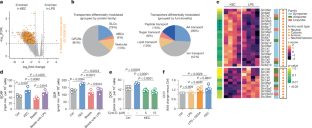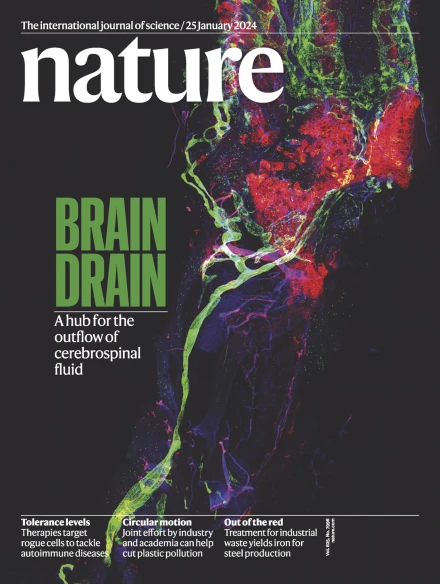Macrophages recycle phagocytosed bacteria to fuel immunometabolic responses
IF 50.5
1区 综合性期刊
Q1 MULTIDISCIPLINARY SCIENCES
引用次数: 0
Abstract
Macrophages specialize in phagocytosis, a cellular process that eliminates extracellular matter, including microorganisms, through internalization and degradation1,2. Despite the critical role of phagocytosis during bacterial infection, the fate of phagocytosed microbial cargo and its impact on the host cell are poorly understood. In this study, we show that ingested bacteria constitute an alternative nutrient source that skews immunometabolic host responses. By tracing stable isotope-labelled bacteria, we found that phagolysosomal degradation of bacteria provides carbon atoms and amino acids that are recycled into various metabolic pathways, including glutathione and itaconate biosynthesis, and satisfies the bioenergetic needs of macrophages. Metabolic recycling of microbially derived nutrients is regulated by the nutrient-sensing mechanistic target of rapamycin complex C1 and is intricately tied to microbial viability. Dead bacteria, as opposed to live bacteria, are enriched in cyclic adenosine monophosphate, sustain the cellular adenosine monophosphate pool and subsequently activate adenosine monophosphate protein kinase to inhibit the mechanistic target of rapamycin complex C1. Consequently, killed bacteria strongly fuel metabolic recycling and support macrophage survival but elicit decreased reactive oxygen species production and reduced interleukin-1β secretion compared to viable bacteria. These results provide a new insight into the fate of engulfed microorganisms and highlight a microbial viability-associated metabolite that triggers host metabolic and immune responses. Our findings hold promise for shaping immunometabolic intervention for various immune-related pathologies. Phagocytosed bacteria can serve as an alternative nutrient source for macrophages, influencing their metabolic and immune responses through the recycling of microbial components, with the process regulated by nutrient-sensing mechanisms and bacterial viability.


巨噬细胞回收被吞噬的细菌,促进免疫代谢反应
巨噬细胞专门从事吞噬作用,这是一种通过内化和降解消除细胞外物质(包括微生物)的细胞过程1,2。尽管吞噬作用在细菌感染过程中起着关键作用,但被吞噬的微生物货物的命运及其对宿主细胞的影响尚不清楚。在这项研究中,我们表明,摄入的细菌构成了扭曲免疫代谢宿主反应的另一种营养来源。通过追踪稳定同位素标记的细菌,我们发现细菌的吞噬溶酶体降解提供了碳原子和氨基酸,这些碳原子和氨基酸被循环到各种代谢途径中,包括谷胱甘肽和衣康酸的生物合成,并满足巨噬细胞的生物能需求。微生物来源的营养物质的代谢再循环是由雷帕霉素复合物C1的营养感应机制靶点调节的,并且与微生物活力密切相关。与活菌相反,死菌富含环腺苷单磷酸,维持细胞腺苷单磷酸池,随后激活腺苷单磷酸蛋白激酶,抑制雷帕霉素复合物C1的机制靶点。因此,与活菌相比,被杀死的细菌强烈地促进代谢循环和支持巨噬细胞存活,但导致活性氧产生减少和白细胞介素-1β分泌减少。这些结果为被吞没的微生物的命运提供了新的见解,并强调了触发宿主代谢和免疫反应的微生物活力相关代谢物。我们的研究结果有望对各种免疫相关病理进行免疫代谢干预。
本文章由计算机程序翻译,如有差异,请以英文原文为准。
求助全文
约1分钟内获得全文
求助全文
来源期刊

Nature
综合性期刊-综合性期刊
CiteScore
90.00
自引率
1.20%
发文量
3652
审稿时长
3 months
期刊介绍:
Nature is a prestigious international journal that publishes peer-reviewed research in various scientific and technological fields. The selection of articles is based on criteria such as originality, importance, interdisciplinary relevance, timeliness, accessibility, elegance, and surprising conclusions. In addition to showcasing significant scientific advances, Nature delivers rapid, authoritative, insightful news, and interpretation of current and upcoming trends impacting science, scientists, and the broader public. The journal serves a dual purpose: firstly, to promptly share noteworthy scientific advances and foster discussions among scientists, and secondly, to ensure the swift dissemination of scientific results globally, emphasizing their significance for knowledge, culture, and daily life.
 求助内容:
求助内容: 应助结果提醒方式:
应助结果提醒方式:


